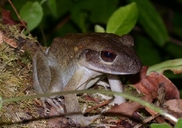|
Cornufer vitianus (Duméril, 1853)
Fiji Ground Frog, dreli, botoniviti | family: Ceratobatrachidae subfamily: Ceratobatrachinae genus: Cornufer |
 © 2004 Clare Morrison (1 of 8) |
|
|
|
Description Distribution and Habitat Country distribution from AmphibiaWeb's database: Fiji
Life History, Abundance, Activity, and Special Behaviors Males call from elevated perches in trees, low shrubs and rocks. The advertisement call is a short, sharp whistle. Both sexes have been reported to have distress calls (Narayan et al. 2008): rubbing the underbelly gently will induce males to emit a softer call that sounds like bird chirps, while females emit a louder distress call that resembles a dog barking. Amplexus has not been observed. Approximately 40 large, white eggs (4-7mm diameter) in moist rotten logs on the ground. Coconut husks are also used as egg deposition sites (Ryan 2000). Gravid females have been observed throughout the year on Viwa Island, indicating that reproduction is probably continuous rather than annual (Narayan et al. 2008). However, breeding frequency (gauged by observation of metamorphs, froglets and egg masses) does show a rise towards the end of the year on Viwa Island, coincident with higher rainfall (Narayan et al. 2008). The male may guard the clutch (Narayan et al. 2007b). There is no tadpole stage and the eggs take 4-5 weeks to develop directly into froglets. Good swimmers and capable of leaps of >1m. When threatened will puff themselves up with air and release copious amounts of bladder water. When under duress will occasionally vocalise with a series of short, almost birdlike calls. Insectivorous. Trends and Threats Currently this species is only known from five mongoose-free islands and one population on Vanua Levu (second largest island in Fiji, has mongoose). Due to its small, fragmented extent of occurrence and continuing decline due to predation it is currently listed as Endangered under IUCN (2008) criteria. A captive breeding program was initiated in 2006 by scientists at the University of the South Pacific, using ten frogs from Viwa Island (Narayan et al. 2007a; 2007b; 2007c). Possible reasons for amphibian decline General habitat alteration and loss
References
Gorham, S. W. (1971). ''Field identification of Fiji's frogs.'' Fiji Agricultural Journal, 33, 31-33. Morrison, C. (2003). A Field Guide to the Herpetofauna of Fiji. Institute of Applied Sciences, University of the South Pacific, Fiji. Narayan EJ, Jessop TS and Hero J-M (2015). "Invasive cane toad triggers chronic physiological stress and decreased reproductive success in an island endemic." Functional Ecology, 29, 1435-1444. [link] Narayan, E, Christi, K., and Morley, C. (2007). ''Captive management of newly hatched Fijian ground frog Platymantis vitianus froglets: lessons learnt from an unanticipated invertebrate predator invasion, Suva, Fiji.'' Conservation Evidence, 4, 58-60. Narayan, E, Christi, K., and Morley, C. (2007). ''Improvement in ex-situ egg hatchability of Fijian ground from Platymantis vitianus by laboratory incubation of egg masses, University of the South Pacific, Suva, Fiji.'' Conservation Evidence, 4, 25-27. Narayan, E., Christi, K. and Morley, C. (2007). ''Provision of egg-laying sites for captive breeding of the endangered Fijian ground frog Platymantis vitianus, University of the South Pacific, Suva, Fiji .'' Conservation Evidence, 4, 61-65. Narayan, E., Christi, K., and Morley, C. (2008). ''Ecology and reproduction of the endangered Fijian Ground Frog Platymantis vitianus - Fiji Islands.'' South Pacific Journal of Natural Science, 26, 28-32. Ryan, P. A. (1984). ''Fiji amphibia.'' Domodomo, 2(2), 87-98. Ryan, P. A. (1985). ''A coastal habitat for Fiji's ground frog and a first record from Gau.'' Herpetological Review , 16(3), 72. Ryan, P. A. (2000). Fiji's Natural Heritage. Exisle Publishing, New Zealand. Zug, G. R. (1983). ''Natural history notes on the ground frog (Ranidae, Platymantis vitianus).'' Herpetological Review, 14(3), 68-69. Originally submitted by: Clare Morrison (first posted 2004-02-24) Trends and threats by: Michelle S. Koo (updated 2021-11-05)
Edited by: Kellie Whittaker, Michelle S. Koo (2021-11-05) Species Account Citation: AmphibiaWeb 2021 Cornufer vitianus: Fiji Ground Frog <https://amphibiaweb.org/species/4920> University of California, Berkeley, CA, USA. Accessed May 22, 2025.
Feedback or comments about this page.
Citation: AmphibiaWeb. 2025. <https://amphibiaweb.org> University of California, Berkeley, CA, USA. Accessed 22 May 2025. AmphibiaWeb's policy on data use. |



 Map of Life
Map of Life